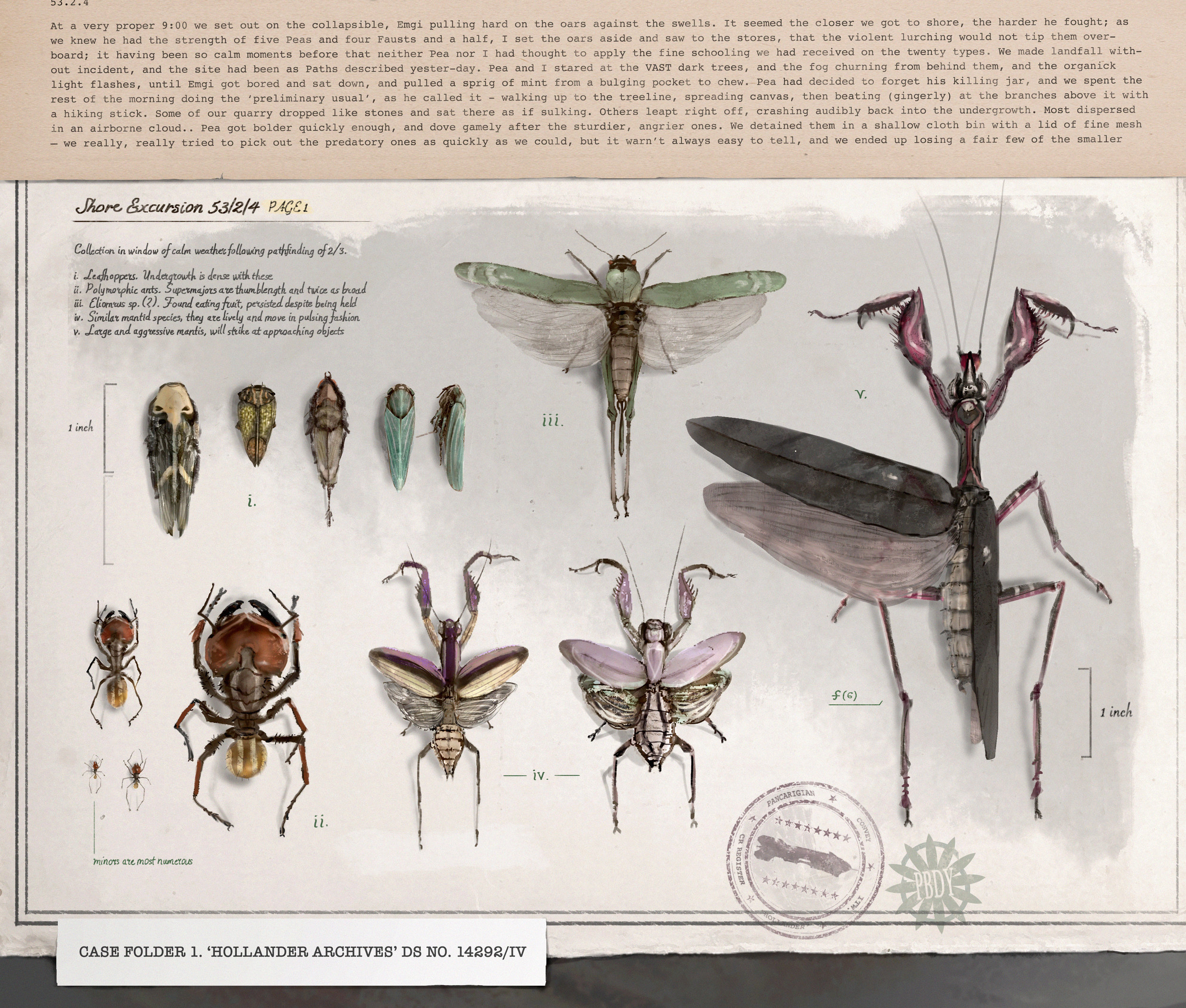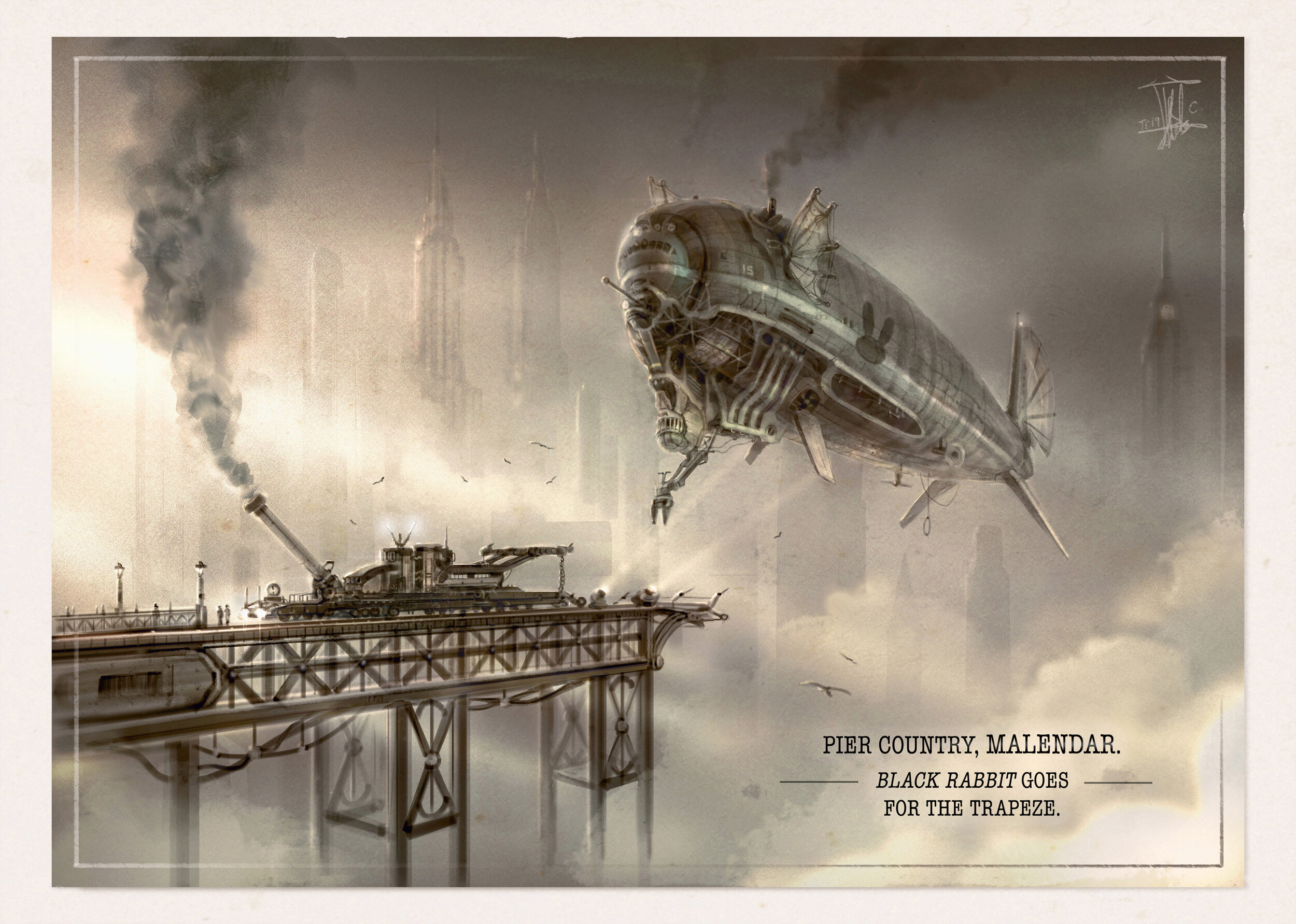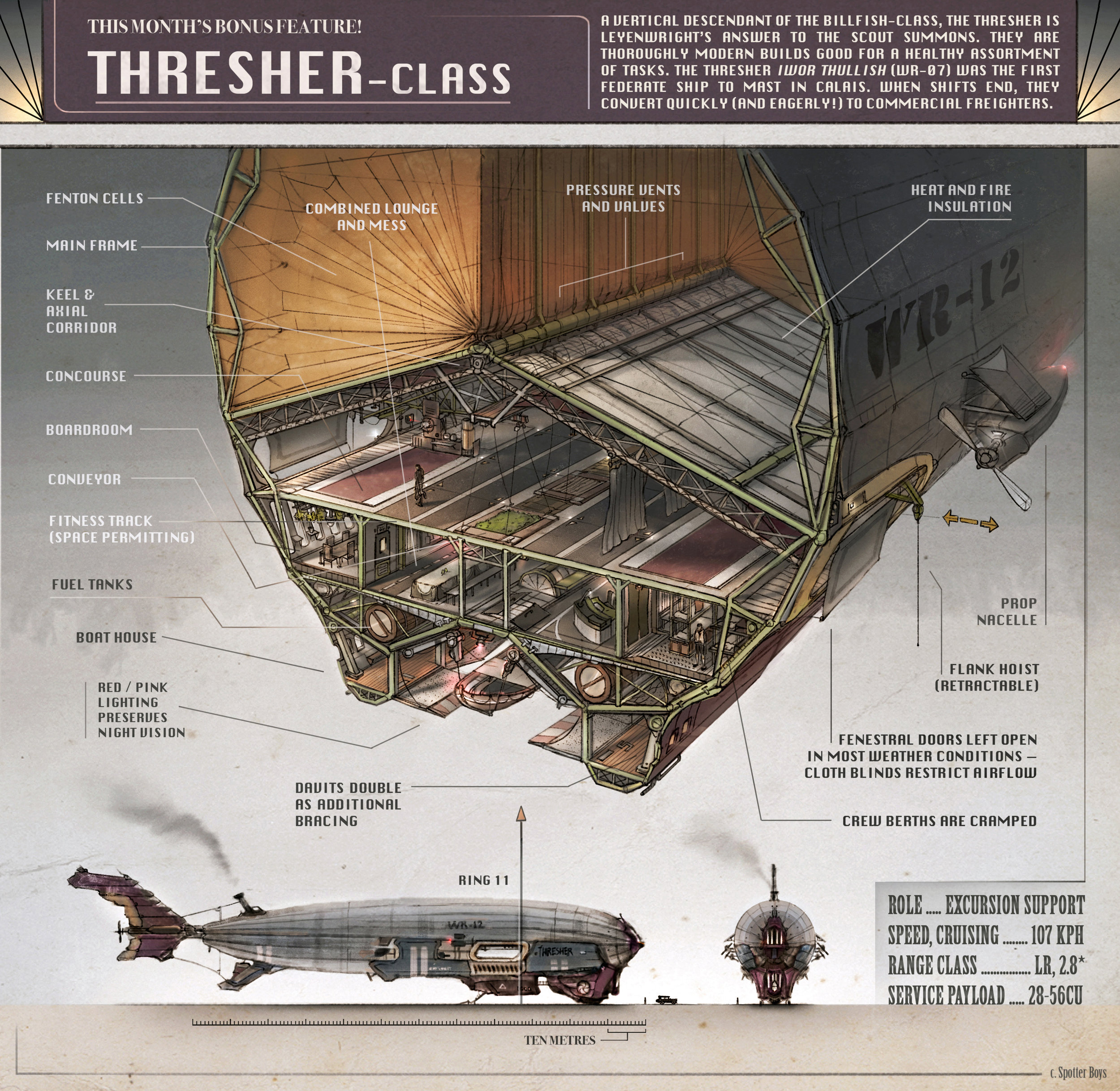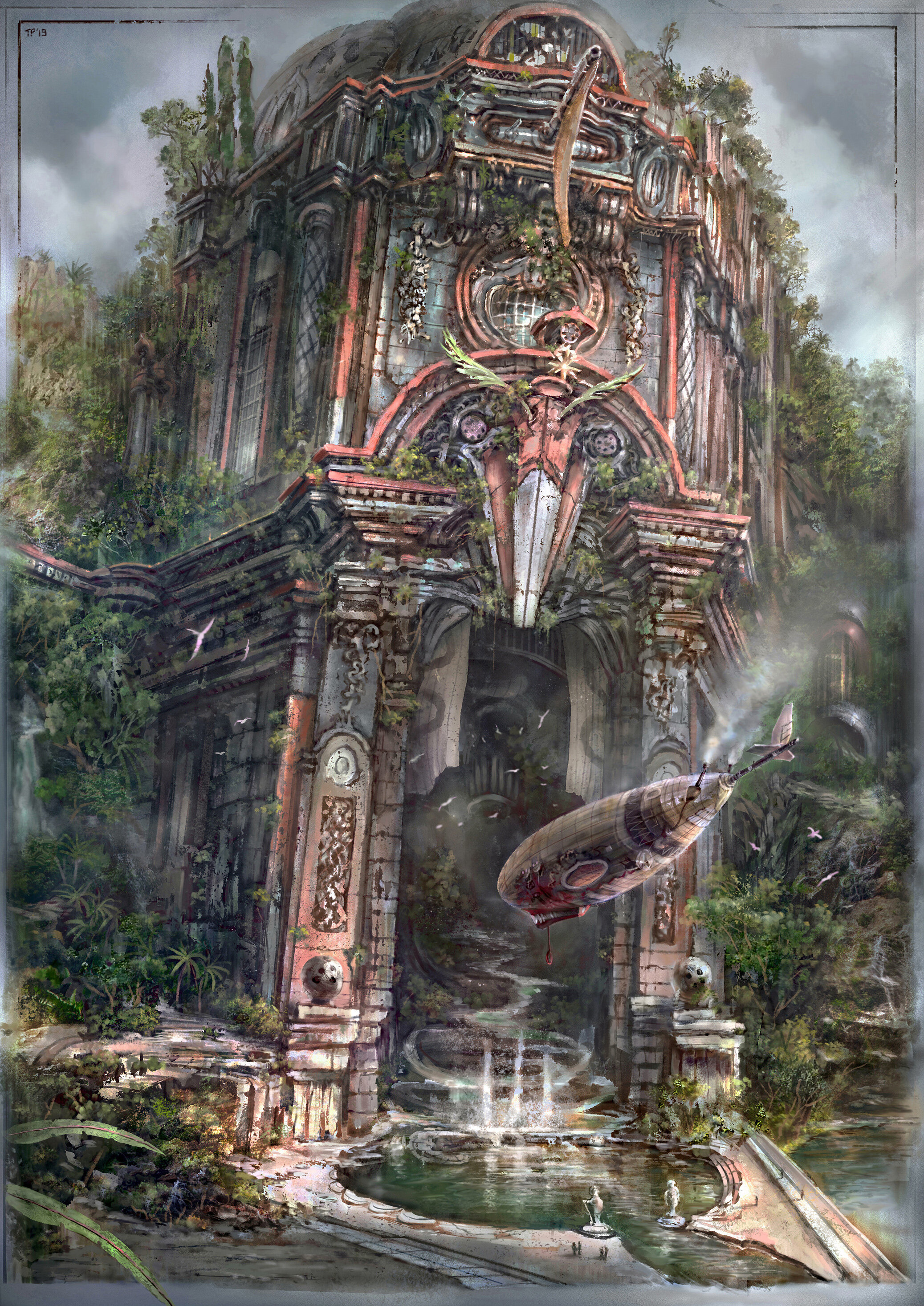

























'At a very proper 9:00 we set out on the collapsible, Emgi pulling hard on the oars against the swells. It seemed the closer we got to shore, the harder he fought; as we knew he had the strength of five Peas and four Fausts and a half, I set the oars aside and saw to the stores, that the violent lurching would not tip them overboard; it having been so calm moments before that neither Pea nor I had thought to apply the fine schooling we had received on the twenty types. We made landfall without incident, and the site had been as Paths described yester-day. Pea and I stared at the VAST dark trees, and the fog churning from behind them, and the organick light flashes, until Emgi got bored and sat down, and pulled a sprig of mint from a bulging pocket to chew. Pea had decided to forget his killing jar, and we spent the rest of the morning doing the ‘preliminary usual’, as he called it - walking up to the treeline, spreading canvas, then beating (gingerly) at the branches above it with a hiking stick. Some of our quarry dropped like stones and sat there as if sulking. Others leapt right off, crashing audibly back into the undergrowth. Most dispersed in an airborne cloud.. Pea got bolder quickly enough, and dove gamely after the sturdier, angrier ones. We detained them in a shallow cloth bin with a lid of fine mesh — we really, really tried to pick out the predatory ones as quickly as we could, but it warn’t always easy to tell, and we ended up losing a fair few of the smaller...'
(~ More material attributed to the natural history locus aboard the CR Hollander. The content is amateur but nonetheless earnest and reliable public education.~)

CG-registered guildships like the Hollander were mandated to discuss their surveys with the great Iaran societies. Though scoffedly amateur by the standards of Federate academies, the most engaged natural historians aboard the itinerant airships brought back stacks of earnest and largely reliable observation. This page is from the cache of the Hollander herself, retrieved years after her crash. It is attributed to Adrian Faust, who studied under resident amateur Conrad Peabody.

MIDDLE CALAIS: Qentin Doras (Quentin transit-hall) sends clattering ‘Canton Cars’ over the Welbern Sinkhole, and retrieves them the next morning. The terrain around Welbern is somewhat gentler than the rule (though still dominated by the rifts, fissures, and scarps that make the entire basin such a challenge to traverse). It is also unusual for being largely and often permanently submerged in tidal ‘dark’ water.
OOC: This piece was part of a two-part experiment examining design differences between my two ‘worlds’ FINDING CALAIS and PASTEL SKYCUBES.

Here’s Ilusia Welmisley in Middle Calais. Its two hundred and four residents have found home in a high place: a sheer-sided rock rising a mile out of the steam of the Talimore fissures. In contrast to the monumental scale of the engines and edifices lurking in the depths of these parts, building styles here are quaint and reminescent of peripheral communes like Rial and Denquien. Daytime visitors are common, being typically drawn by such things as the view, the quiet terrace cafes, the winsome, chill air, and the small but ornate terrariums. These last specialise in the curation and conservation of highland invertebrates unique to these parts. Ilusia Welmisley is also a famed stopping point for the annual migration of several species of Carentan swift. The birds unsurprisingly arrive with the onset of the autumnal ‘moth season’, when lazy white clouds of wanly fluttering pearl moths take to the air and catch the sun in explosions of iridescent colour.

Malendar’s urban fissures are relatively shielded from buffeting winds, but larger airships are still unable to traverse them. A number of solutions to this familiar problem are in use, the most iconic one being to, well, ‘catch’ a train! The result has been the construction of an extensive system of elevated trackways plyed by locomotives that specialise in pulling these aerial giants safely through the Iaran capital’s dense cityscape.
‘ ~ Elevated transit brings a special kind of wonder to cities, doesn’t it? Such variety, dynamism, and adventure are added to the scene.’

Travel writer Munse Egbert wrote, ‘The prow of a mighty, steep-sided plateau rose from a gently curling sea of cloud. It spread like a Fakhlan rug before a noble crag that stood between it and the glowering banks of brume that threatened to brim and wash down over it all. But covering the rug itself, another carpet: a gleaming one of construction, bristling with proud spires. From this distance one already sees how each was tall and stately as it was massive. Each met the sun in warm hues of bronze, copper, and gold, from immersed feet to tapering tips — a half-mile high, the greater ones were, yet none made more than a trifling contribution to the scale of the Gilded City. The skyscrapers of Malendar had always reached up, up out of the welter of brick, limestone and glass, reached to outdo their neighbours for a greater share of the sun’s grandeur. And around that shimmer of countless buildings – from the shoaling, darting specks that were planes to the quiet drifting leviathans that were unmistakeably the great dirigibles – aircraft, scores of aircraft once you looked close enough, the planes jostling and diving into the mass of construction, the airships – some trailing vivid billboards that would’ve covered a city block – lounging among the spires, circling lazily in clear skies, clustering to mast wherever city dropped off into cloud.
That plateau – properly a ‘mesa’ to the thriving geographical societies operating from it – that was Calenbar. Upon it, Malendar: capital of Federate Iara. When the sun slants into golden hour on a clear day, Malendar resembles a sheer-sided isle of jewels in the heavens. Sunlight, sparing nothing from the splendour of its touch, glances not only off the city, but in shades of brilliant ochre off the exposed plateau walls.
Other times the cloudsea rises to engulf the city, and all its souls with it. For full days at end one might be shrouded in wet, gray, chill murk too thick to drive a cart in. There will be little colour to speak of. No plane will fly, and such airships as can will have to grab and be dragged around dim urban fissures by straining locomotives. Malendar’s legion foglights will be roused to do battle with the murk, and in the white veil that follows, pilferers and misfits will in some districts outnumber the regular publick. One must be doughty to walk the streets then; most will quite sensibly prefer not to descend at all, but to strike for as many sky bridges as one needs to board the nearest el…’
So much has been and can yet be written of the gilded city; Egbert’s is but one account. This seemingly impossible place has grown over the centuries around foundations that have had to be reworked and strengthened with each generation passed. The plateau Calenbar’s largely rocky interior, in places brittle and porous, is now a fifth steel and concrete by volume, an amount which must surely increase until less than half of the original substrate remains. Five elevators the size of ocean liners shuttle goods and sundry to and from docks a mile and a half below; there steamers ply a maze of rivers and lakes lapping wanly through the gorges and caverns that radiate wildly across and under otherwise dry, barren tracts of land. A trip on an elevator is quite the experience. You leave the chill draughts and (often enough, at least) dazzling clarity of Malendar, plunge into the mile-thick, shifting innards of beleaguering clouds, and emerge in the span of a few minutes into a dusty, yellowed, stifling warm underworld. Few people care to live or work here; it is called ‘Wastes’ or ‘Lifeless Plains’ for good reason, and is littered with dead factories, dead towns, derelict engines, and the occassional shanty. Anyhow, one cannot go very far on the waters that snake furtively about this land. Excepting the one tributary that manages only just to reach the next state Eadar, they serve only the far towns of the metropolitan region before vanishing underground.
No, Malendar’s panCarigian interests are better served by rail and, better yet, by air…

MALENDAR: Having completed its morning run, the airbus Major Ty has been ‘clipped’ by steam tractors and pulled to a quiet neighbourhood terminal. About it a midday veil has settled diaphanous about the union city’s sprawling welter of towers.

The Thresher is an excursion support ship, usually present in a cluster at the centre of any shoaled venture beyond planar Iara. They have decent payload capacity, and a concourse well stretching a good third of the envelope's length. Sundry logistics like tents and rations thus fall often within their purview. They are by no means specialised freighters, though, for they lack dedicated, reinforced floor space for true heavy lifting.

IR CARGAI: ‘The ships left to our excursion latched at the foot of one of these titanic, gnarled trees, jostled by warm drafts from the row of caves staring out from between its roots. We were tied like minnows against this heartening river of warm air. For all the night the current flagged only once, for an hour round before midnight, and then it continued to caress the hides of our vessels. We’d lit no lamps that would chance revealing our position — not even markers — and this was more to evade barnacling swarms of deranged arthropod visitors than it was for fear of being found out by Manohar, or one of the many types of large vertebrate fiend that menaced the inky Cargai night. At least there were the black lounges to retreat to, for there we kept chunky dynamo lamps blazing. Those who could not sleep lay on fraying divans in these converted freight lockers reading, writing, sorting notes, or (and this was most popular) staring into space listening with drooping eyelids to recorded radio shows.
’But before the dawn all was changed, and calls of wakening beasts began to drift through from the layers of forest above, and then by degrees we could see again. Of course we took heart, and held fast council, and while coffee was roasting in three separate drawing rooms, those rostered pulled their boots from damp vestibules and descended for a quick survey..’

Cold afternoon has lapsed into chill dusk. Light shows add colour and life to the geysers and falls so common in the heavily fissured basin of Calais: the Lost City Found. Around them ranks of great infrasound pipes shudder and hum atop their vents, they have stood for generations against the hours of murk. But an age has dawned, now, when they will no longer be needed.
_________________________________________
Image released over two days for the instagram.

Pipe dreams on a cool night at the edge of town. Functioning pipe organs dot the Calaisian landscape. Only the largest have true defensive utility; the rest play important civic and cultural roles.

Ta Cephalion is a sentinel carved out of a rocky outcrop. Note the organ console; the pipes are too 'small' to scramble Morgaff sensibilities, but are nonetheless an effective deterrent.

A drawing of the Tanistroph Organ in Tallia, Calais. Note the paired guns in the side of the landward facade. Though seldom operational, they continue to look out each night over the lake.

`The eight domes of the Octan Palace cluster over the cold waters of its eponymous vale. There are notes of salt in the air, mist from the fountains, the echoing of footsteps in halls curtained from sight. To our sensibilities the impossibly complex facades before us seem to flit, with each subtle change of the light, constantly between the beautiful and the macabre. O, the wild, exuberant extent of their ornament! Great fronts of cloud are passing overhead, and when they blot the sun the gloom under the glittering eaves appears to writhe with dark life. But of course the complex must serve, in a fashion, to intimidate. We are told that it houses a martial pipe organ of respectable size; that, when its most genial ranks thrum subtly to life each evening, it is firm cue for promenaders to leave. When the Morgaff concert has thundered its last, the lullabies of Calais will begin to call gently and sweetly from the municipal stops, and the palace will become a refuge for the sleepless. The library (replete with shelters that resist the worst of the martial infrasound) never closes. Its warm lights shine bravely against the hours of night.’
***
The Octan Palace straddles the last run of the Tixia cascades. Principal architect Erin Bold (a student of the famously controversial L. Rowe Fleury) was inspired by the filterfeeding crustacean stygofauna that regularly swarm in the pools at its feet. There the cold waters from the cascades meet warm, mineral-heavy jets from vents and geysers, leading to explosions of planktonic life.

REIUDEN, MIDDLE CALAIS: The Thomasian ‘Water Door’ of Fort Bomm is a looming wilderness of weathered, cannon-studded ornamentation built up over five storied centuries of use. Like the many clearly martial testimonies to the region’s more turbulent past that still dot the landscape, the installation is no longer active. Barring its occasional activation as a checkpoint for airships on movement trials, it keeps only a skeletal crew tasked with ensuring its dormant innards remain potentially operable. In the words of one Maurice Mandrake, this often amounts to ‘pulling weeds off dead engines’, an uphill task which youthful volunteers from nearby communes can nonetheless be persuaded to delight in.

‘The poor fellows, scrawled Adrian, lounging against a rock, ‘.. cannot agree on what they have found.’

‘The poor fellows, scrawled Adrian, lounging against a rock, ‘.. cannot agree on what they have found.’

Airships must pass extensive certification trials before they are loosed upon the fissure-striated landscape of Calais. Requirements are strictest for the smallest classes, for they will enjoy the greatest freedom of movement. The infamous Wender Log features often in circuits for ‘sprightly little ships’ like this parcel hopper!
A fun little piece for my belle epoque fantasy :)

The vivarium Elia Calayuuden, from the notes of A.FaustHall. He did what he could for the ship’s log on his convalescent sojourns across Calais.

A light-hearted tribute to the spirit of exploration. Take a breather, don’t miss the marvels on the way? (:

INNER CALAIS: Cara Etain as seen from the west. The complex presides over the somewhat hushed neighbourhood at the 'back door' of steam-shrouded Talimore.

You crest the last rise, and bask in home's amber glow. Today's evening post has dropped in to cinch; it won't tarry long, and if you hurry you might make it in time to procure something interesting from its store. Gasjacks these days are an enterprising lot.